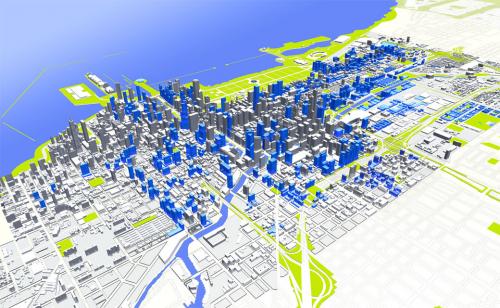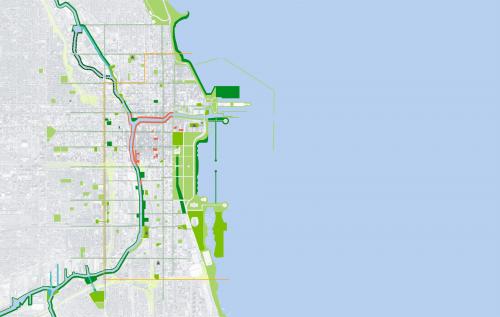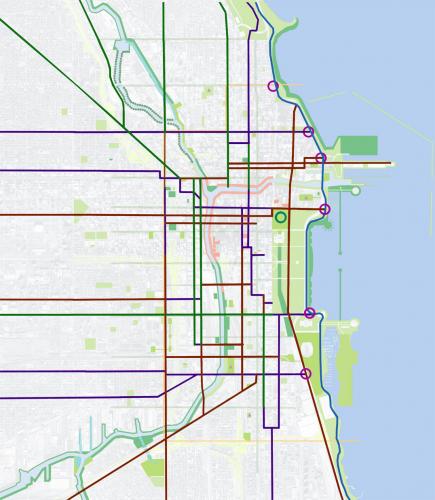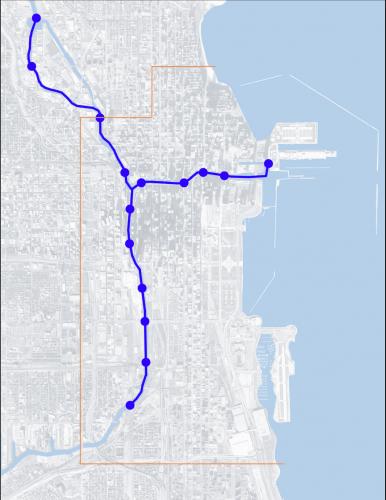
Chicago's Central Area Plan sketches an ambitious vision for the future of the city's core.
For the past 100 years, when planners spoke of “the Chicago Plan,” chances are they had in mind the Burnham Plan of 1909. Well, today there is another plan of note: The Chicago Central Area Plan of 2003. I had the chance to spend some time with the principal consultant, Phil Enquist of Skidmore Owings & Merrill, just as the plan was coming out, and then to see the changes occurring on the ground in the spring of 2006. In the Chicago way of making no little plans, this 20-year framework is based on a vision of Chicago as a global city, the downtown of the Midwest, the heart of the region and the greenest city in the country. No small ideas, these.
Subtitled Preparing the Central City for the 21st Century, the Chicago Central Area Plan was prepared for a three-department client group — the Department of Planning and Development, the Department of Transportation, and the Department of the Environment — a line-up that reflects the breadth of aspirations of the mayor and the city. It is nothing less than the next step in Chicago’s hundred-year quest to build the world’s greatest city, and build it according to a plan. When one looks back at the results of each of Chicago’s past plans (1909, 1958, 1973 and 1983) there is a long list of specific accomplishments — parks, boulevards, a civic center, museums and stadiums. These are some of those things that contribute both to the great beauty and economic prowess of Chicago - the things that make it, in my view, the most beautiful city in the Americas.
The Central Area makes up 2 percent of the area of the city, and includes its commercial and office downtown: “The Loop,” the first ring of residential neighborhoods and large areas of formerly industrial lands. In 2003, the Central Area contained 107 million square feet of office, 9 million square feet of retail and 56,000 residential units. By 2020, the Plan projects 30 million to 40 million additional square feet of office, 5 million to 7 million square feet of retail and 40,000 additional residential units, bringing the residential population to 150,000 people.
The Plan measures a hefty 150 large-format pages, and is profusely illustrated with color plans, sections, analytic diagrams, photos and drawings. It is filled with both grand strokes and subtle details that are worth study by anyone who loves cities. But I believe it will be most valuable in this short summary to concentrate on its vision and major themes.
The Vision
Chicago’s Central Area in 2020 will be known worldwide as a beautiful, dynamic urban center that is the hub of business, higher education and culture for its region. It will have the greenest downtown in America, known for its outstanding lake and riverfront, parks and greenways, its exceptional public transportation, and for its policies promoting innovative architecture and environmentally-sustainable design and practices. It will be a vibrant, walkable place where people work, live, play and celebrate. It will attract and serve people from every Chicago neighborhood, as well as visitors from around the nation and around the world.
The Plan recognizes that downtown Chicago will grow because the underlying economic fundamentals are there. Its mid-continent location, its function as a hub — first for railroads and now for airlines and fiber optic networks — its thoughtful planning and public investment, its economic diversity, all mean that people want to be in Chicago. In the past 20 years the Central Area added 40 million square feet of office space and more downtown residents than any other U.S. city. The plan also recognizes what is needed to sustain that growth:
This growth, which is good for the city and smart for the region, can only be sustained if the Central Area builds on the special qualities that make it one of the world’s greatest places to work, live and play.
The Central Area is planned to be the greenest downtown in the United States, with a network of parks and greenways.
Chicago and New York City are the only two cities in the United States that have a majority of their region's jobs in the city. With the 70 percent increase in new residents will come new public facilities and services, including major growth in health-care facilities. Expanded convention and other visitor facilities will demand an additional 10,000 hotel rooms. Higher education, already important in the Central Area, will add 3 million square feet of classrooms, dormitories and support space, serving a total of 95,000 students.
Themes
There are three guiding themes to the Central Area Plan:
- Direct growth to create a dynamic Central Area made up of vibrant and diverse mixed-use urban districts. The plan calls for an expansion of the high-density office core, strengthening of industrial corridors and planned manufacturing districts, reinforcing livable neighborhoods, directing the growth of educational institutions, and promoting the development of cultural facilities.
- Strengthen connections to keep the Central Area easy to reach and get around. The plan states that an important action will be to make transit the first choice of people coming to the Central Area, as well as improving the pedestrian realm, managing traffic and parking, encouraging bicycles, and water taxis.
- Expand and connect waterfronts and open spaces to create great public places. The Central Area plan recognizes both the lakefront and the Chicago River as major attractions to be reinforced. It also calls for a continuation of the lavish landscaped streets that characterize the Central Area, and development of the next generation of neighborhood parks.
Of course, the proof is in the pudding. Many, if not all, of these themes can be seen in practice on block after block in the Central Area.
Bikeways are planned to connect the Central Area's waterfront and open spaces.
Lessons Learned
Chicago is Chicago and San Francisco is San Francisco, and they are very different places. Each has its own valuable history and traditions. But I think it is worth noting some beliefs, as exemplified in the Central Area Plan, that make Chicago such a dynamic, beautiful city:
- A healthy economy is key; job growth is what ultimately supports everything else.
- Cities and neighborhoods and districts are dynamic — they are either growing or shrinking, and there is hardly such thing as stasis.
- Chicago can develop a shared vision for the future
- Chicago has the power to make that city the most beautiful, prosperous, equitable city anywhere, and is doing so.
It is this optimistic belief in the future, a sense of confidence, that exudes from not only the Central Area, but from neighborhoods big and small throughout the city. Coming on the heels of the World’s Columbian Exposition of 1893 and the Burnham Plan of 1909, Chicago has always had this vision of itself as the greatest city in the world. Cab drivers, bellhops and store clerks can tell you about “The Plan” (which was taught in elementary schools for several decades), the name of the latest hot architect and what she is designing next, and how the mayor is leading the city into the 21st century.
A system of water taxis includes stops throughout the Central Area.
Rather than being dragged kicking and screaming into the future, the city embraces creativity as they currency of the future, from the green roof on City Hall to the contemporary sculpture in Millennium Park. There’s an understanding that in a mobile economy with a mobile workforce, it’s about quality of life; that housing costs can be held down by dramatically increasing the supply; that spending the money to create an excellent physical environment does make a difference; that city planning is key; and building a major city requires major power.
If you haven’t been to Chicago lately, check it out. And hopefully come back inspired to help San Francisco dream big and make big plans. The results will be different from Chicago’s. But they should be just as exciting.